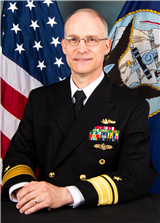 Rear Adm. William Greene
Rear Adm. William Greene
During our General Membership Luncheon at the Chartway Arena in Norfolk on May 21st, Rear Admiral William Greene (Commander, Navy Regional Maintenance Center and Director, Surface Ship Maintenance, Modernization, and Sustainment) delivered a comprehensive and insightful address to our membership.
Rear Admiral Greene began his address by expressing gratitude to Perry Bingham, Bill Crow, Chartway Arena staff, and all attendees. He acknowledged the essential role our association has in supporting the Navy and our workforce. His opening remarks were a warm acknowledgment of the dedication and hard work of our industry, leading right into some of the challenges our hard work combats.
Rear Admiral Greene emphasized the significant national security challenges faced in the Pacific, especially with the Davidson Window approaching. He also highlighted the unprecedented combat engagement involving Navy ships in various global hotspots, including the Mediterranean, Red Sea, and the ongoing conflict in Gaza. He stressed the importance of the ship repair industry in ensuring fleet readiness to meet these challenges, getting "more players on the field".
The Admiral outlined goals for the Navy, including achieving 75 mission-capable ships by the end of FY24 and reaching 90% on-time completion from depot maintenance availabilites by 2027. Asking the crowd about their knowledge of the importance of 2027, Admiral Greene discussed the Davidson Window and how some of the ships being worked on will not be back for repairs before potential major conflict. He underscored the critical role timely maintenance plays in ensuring that the fleet remains operational and ready for deployment.
Sharing current performance metrics, Rear Admiral Greene noted that in FY22, only 36% of maintenance was completed on time. However, through concerted efforts, this figure is projected to improve to 58% by the end of the current year, noted 3 ships that finished on time or early from Norfolk. Additionally, Admiral Greene goes into the Lifecycle Health Assessment (LCHA) of ships over the past years, explaining how the quality of the ships repaired have gone up from around a 50% in 2018 to a 76% projected passing of LCHA in 2024. He did note that it was going to be hard to keep that projected number as the industry works towards the 90% on-time completion.
Rear Admiral Greene discussed several strategic initiatives aimed at reaching the 75 mission capable ships with the 90% on-time completion by 2027. He emphasized the importance of adhering to planning milestones and the involvement of senior leadership in the planning process while monitoring leadership bandwidth. A planning focus seems to be a key factor to reaching this goal, based on the Admiral's words. Additionally, the focus on planning over execution from leadership was a highlighted change needed. The use of executability assessments to review milestones, embed planners, increase use of forecasting tools, and better the position of contingency material seems to be a way of bettering our long-term efforts, with current efforts having paid off based on what Admiral Greene has seen.
Addressing the need to adapt contracting and acquisition strategies to the changing environment of the past 10 years with low ship count and high competition, the Admiral spoke about the collaborative efforts between the Navy and industry stakeholders with a structured and P2P approach. He mentioned the establishment of working groups and executive committees to develop tailored solutions for different ports, aiming to improve outcomes and efficiency.
Rear Admiral Greene identified growth and new work as primary drivers of maintenance delays. He discussed strategies to reduce new work and defer non-critical tasks to future maintenance cycles, including a joint memo with surface TYCOMs. Additionally, he mentioned process changes on how new work is approved and tracked to treat it more like a budget with a focus on requirements for sea trials. This approach is aimed at minimizing disruptions and ensuring that critical maintenance tasks are prioritized.
The Admiral highlighted the importance of shorter, more frequent maintenance availabilities and the potential extension of service life for ships. He stressed the need for thorough life cycle assessments to ensure ships remain in optimal condition and ready for deployment.
Rear Admiral Greene then went into "hot topics" involving the industry. He shared his concern over the local workload deteriorating and forecasted to not change for the better, all the while competition is rising in the area. He shared a few options to combat this, including increasing service life of Flight I DDGs on a case-by-case basis and shortening DDG availablity durations. Admiral Greene then discussed 8010 and hotwork changes.
Additionally, the Admiral went over the positive work being done by VSRA and the partnering being done within our industry. Rear Admiral Greene stressed the importance of open communication and collaboration between the Navy and industry. He encouraged ongoing dialogue to identify and implement innovative solutions, emphasizing that successful outcomes depend on effective teamwork and partnership. He also thanked those in attendance for their involvement with bettering the industry as a whole.
As per the norm, the luncheon concluded with a dynamic Q&A session, where VSRA members had the opportunity to engage directly with Rear Admiral Greene. The session covered a range of topics from technical queries to broader strategic concerns. The Admiral’s candid and insightful responses provided clarity and direction for the industry professionals in attendance.
In conclusion, Rear Admiral Greene’s insights provided valuable guidance for industry professionals, encouraging them to strive for excellence in ship maintenance and repair operations. The Navy’s commitment to maintaining operational readiness and adapting to future challenges through strategic planning and innovation was evident throughout his address.
« Return to Newsletter